They are mainly shade structures with a total or partial vegetated surface.
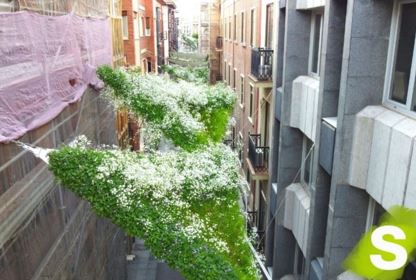
Shelters in Valladolid (Spain), URBAN GreenUP project
There are different types of shading structure, depending on the structure design and the type of vegetation used, e.g. structure could be textile or wood; vegetation could be climbing and hanging plants; and installation could be fixed to the façades or done by posts.
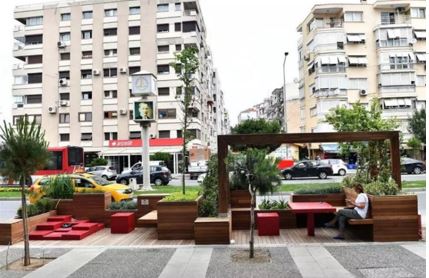
Parklets in Izmir (Turkey), URBAN GreenUP project (https://www.urbangreenup.eu/news--events/news/new-green-areas-to-enjoy-in-izmir.kl)
Shading structures can be located in narrow streets or parks, or intalled in areas that need shaded spaces, such as squares or transport stops.They should be projected in compliance with safety conditions (access to fire brigade, cleaning services, etc.).
Some of the benefits of shading structures are:
- They increase of the amount of vegetation in urban areas, consequently reducing the temperatures by up to 5ºC
- They can act as pollutant filter, capable of trapping or processing over 150kg of NOx and carbon monoxide
- They can attenuate noise up to 40dB
- They can increased commercial activity by increasing pedestrian activity
- They increase in the amount of green spaces per inhabitant without occupying horizontal space
- They affect the revaluation of the property
- They can be used for aesthetic reasons
Some indirect co-benefits are:
- Increase employment rate and jobs
- Increase technological readiness
- Improve land use management
- Improve air quality
- Reduce hot spots/urban heat islands in the city
- Enhance attractiveness of the cities
- Species and pollinator increase
- Increase ecological connectivity
- Green awareness
Climate and Geography:
Green roofs serve several functions related to urban biodiversity (Mann, 2002b). They act as stepping stones between nature reserves, such as parks on the edges of cities, and uncolonized habitats in the middle of the city. They provide a return area for plants and animals that previously inhabited an area that has undergone disturbance and development. They also can serve as permanent substitute habitats for plant and invertebrate communities.
Plants should be chosen in such a way that they are not invasive, are nutritious for pollinators and do not generate allergies, nor are they sensitive to pests. They should also favour the reduction of temperature and increase of environmental humidity to reduce the heat island effect.
Urban Form and layout:
There are different types of shading structure, depending on the possible location within the urban area. Solves the need to provide shade in places where is not possible to plant trees or Green Infrastructures that require more space. These structures can be fixed to the façades or by posts fixed to the sidewalk.
Different variants existing: Arbour, Pergola, Trellis or Green Shady Structures.
Technical aspects/infrastructure:
Green Shady Structures are composed of pieces of stretched textile structure on which an inert substrate is installed. This inert substrate is covered with seeds, which germinate and grow on the textile structure. This NBS can be fixed to the façades of the buildings on the street or by posts fixed to the sidewalk.
Policy and regulatory/legal framework & Project governance and implementation modalities:
The installation of green roofs can earn building LEED points, and if the building reaches LEED certification, can receive tax credits between €6,5 – 57/m2.
All ordinances regarding access to emergency services, municipal services, safety distances for vehicles and pavements, etc., must be taken into account when installing the system.
Funding and financing:
The green shady structures get the recovery of the investment between the 10 and the 20 years.
Economic and social context:
A German study demonstrated that green roof vegetation can significantly reduce diesel engine air pollution (Liesecke and Borgwardt, 1997) Yok Tan and Sia (2005) found a 37% and 21% reduction of sulfur dioxide and nitrous acid respectively directly above newly installed green roof. Others have estimated that green roofs can remove dust particulates per year per square meter of grass roof (Peck and Kuhn, 2001)
Hard surfaces in urban areas are more likely to reflect sound, whereas green roofs absorb sound waves because of the nature of the substrate and vegetation. At the airport in Frankfurt, Germany, a 10 cm deep green roof reduced noise levels by 5 dB (Dunnett and Kigsbury, 2004) Other research shows that 12 cm of green roof substrate alone can diminish noise by 40dB (Peck and Kuhn, 2001)
Firefighting regulations: The selected solution must allow the circulation of a firefighting truck and unfold the ladder at any point of the street. The solution with climbing plants doesn’t allow any of those conditions at the narrow streets of the city centre. The adopted solution allows the circulation of the fire truck and also has an emergency mechanism that hooks off the shade very fast so the ladder can be unfolded at any point of the street.
Regulations for the pedestrian and vehicles traffic and minimum separation
Private property, the owners exposed many doubts about it and to get the permission was very difficult
Technical and social difficulties to allocate the supports on the floor. Location of pipes, cables, etc., and to shut down the service to the citizens would be a big disorder to the neighbours. Also, the works to open and close the pavements have a very negative impact on the shops and citizens. The final solution allows a fast installation.
Operational and Maintenance Considerations:
- Maintenance requires a crane for work at heights
- Regular maintenance of the Green Covering Shelter is required, consisting on a monthly visit to the NBS, in which the following tasks are performed:
- Visual inspection of the vegetation status.
- Visual control of irrigation operation.
- Maintenance and start-up of the irrigation system: Filter cleaning, pH and conductivity control.
- Visual control of pests.
- Supply of hydroponics consumables (fertilization, acid, spare parts, etc.)
In addition to that monthly visit, there will be:
- Preventive phytosanitary treatments twice a year (1 in spring and 1 in summer)
- Pruning and growth control twice a year.
- System of telematics control of the irrigation in a maximum term of 3 natural day
- Green Shady structures (URBAN GreenUP project)
- Green Covering shelters (URBAN GreenUP project)
In summer days with a 16 cm thick substrate the temperature can be reduced up to 15ºC. In winter days with the same substrate the temperature under the substrate can be maintained up to 13ºC above the outside temperature. (G. Minke 2005)
A green roof with 20 cm of substrate and expanded clay, is able to retain 90l/m2 of water (Dürr 1995).
The challenges that afford this NBS are:
Climate change mitigation & adaptation:
Green roofs reduce the heat island effect.
They increase the thermal insulation in the building and therefore reduce the use of energy in air conditioning and heating.
Air quality
The plants are able to absorb polluting substances
Green space management
Green roofs increase the green areas and create new little ecosystems
Potential of economic opportunities and green jobs:
This NBS creates new value chains including implementation and maintenance jobs.
Public Health and Well-being:
This NBS is able to reduce noise thanks to the absorption of the substrate and the reflection of its leaves
Urban regeneration
The green roofs increase the economic value of the building.
Water management
The retention layer reduces urban run-off water
- Capacity building for city officials to understand urban metabolisms and circular solution opportunities: https://netzerocities.app/resource-1568
- Capacity building and training: https://netzerocities.app/resource-1578
- Engagement, co-creation and co-design of NBS and Green Infrastructure plans and interventions: https://netzerocities.app/resource-1608
- Loans for Energy Efficiency (EE): https://netzerocities.app/resource-1648
- Integrated land use and urban planning with energy and climate: https://netzerocities.app/resource-1678
- Integrated climate plans for cities (i.e.: SECAPs): https://netzerocities.app/resource-1698
- City water resilience assessment: https://netzerocities.app/resource-1738
- Public procurement for innovative NBS and Green Infrastructure interventions: https://netzerocities.app/resource-588
- NBS and Green Infrastructure regulation and ordinances: https://netzerocities.app/resource-1813
- NBS and Green Infrastructure plans and strategy design and governance: https://netzerocities.app/resource-1823
- NBS and Green Infrastructure Mapping: https://netzerocities.app/resource-1863
- Parklets in Izmir (Turkey), URBAN GreenUP project
- Leafskin, Green Shady Structure (OPPLA)
- Green shades (sombras vegetales) - Singular Green
-
Green Shady Structures, URBAN GreenUP: In the city of Valladolid, each one of the pieces is triangular with an approximate length of 4m on each side.
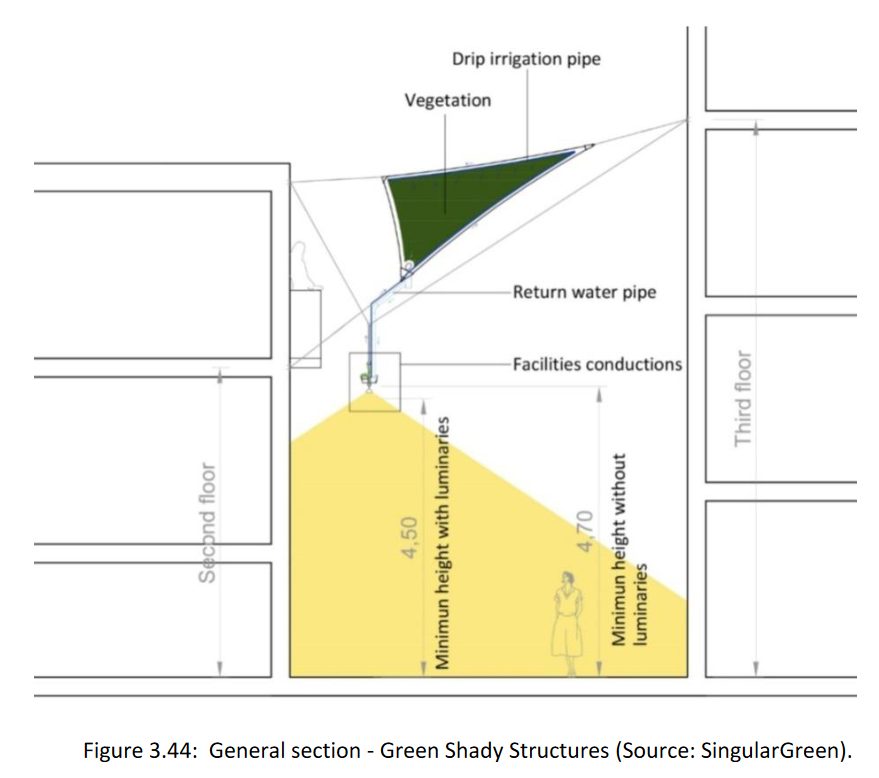
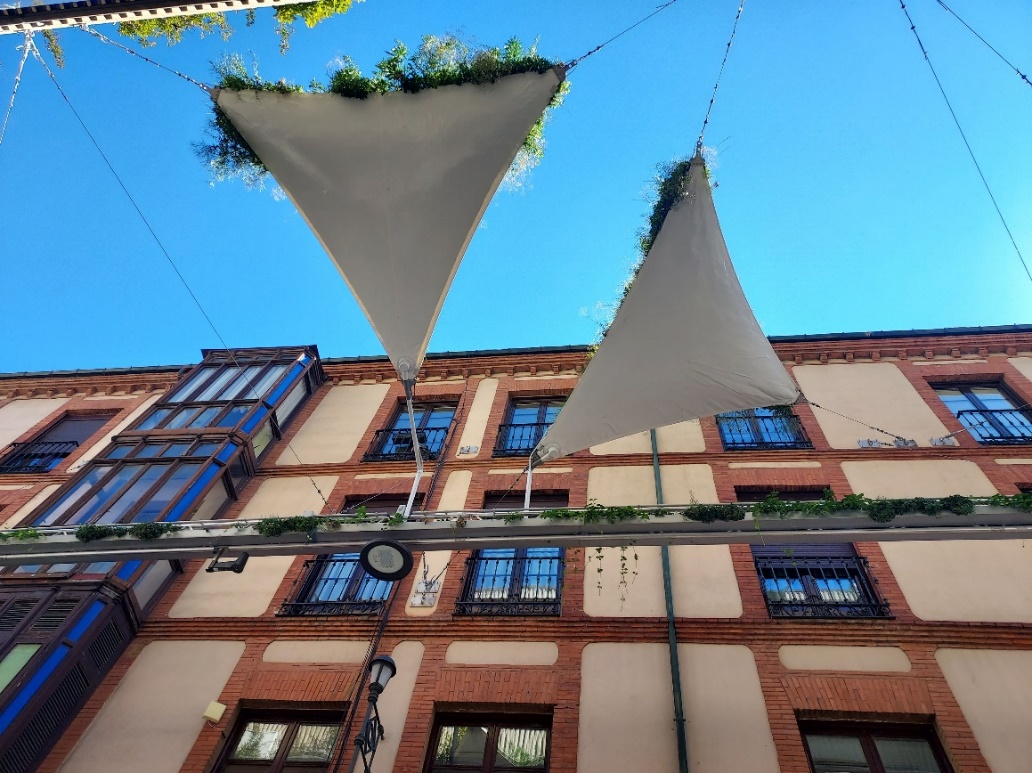
Canopies where you can see the anchoring system to the facade, as well as the drainage pipe of the canopy that goes to a canalisation that was also used for planting. In addition, an efficient lighting system with sensors has been installed that is activated by the approach of people and attenuates the light after a period of time with no pedestrians. (source: URBAN GreenUP)
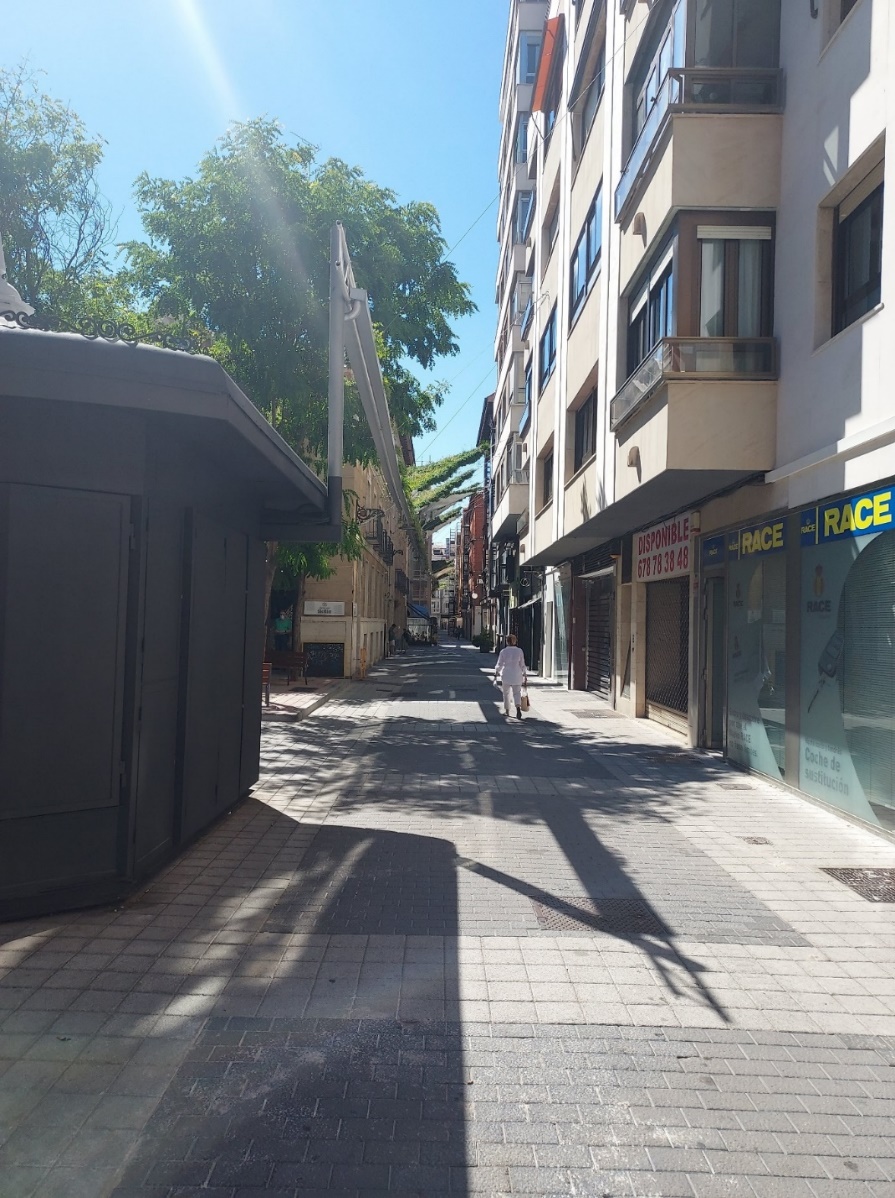
Press kiosk converted into an irrigation station, where it houses the connection to the water network, and a hydroponics / fertigation system with fertiliser, EC and pH monitoring controlled by remote control and piping that carries irrigation to the awnings/sails and collects excess water for reuse. (source: URBAN GreenUP)
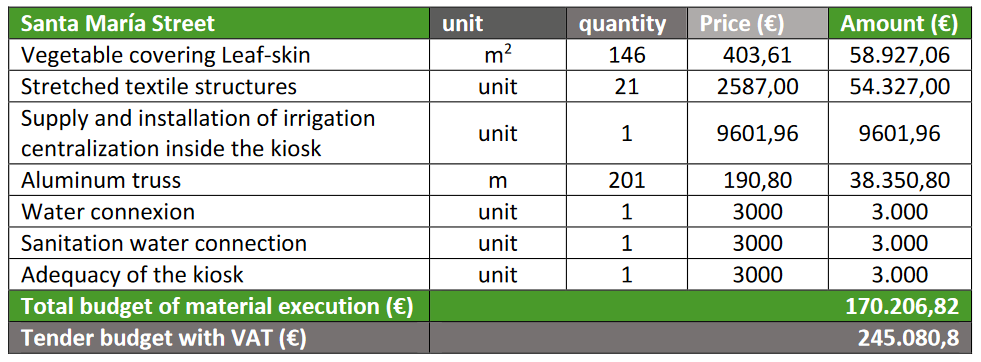
Arbour, Pergola and Trellis:
Comments ()